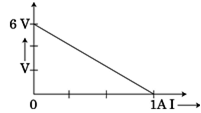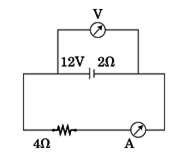 Short Answer Type
Short Answer TypeA charge ‘q’ is moved from a point A above a dipole of dipole moment ‘p’ to a point B below the dipole in equatorial plane without acceleration. Find the work done in the process.

In what way is the behaviour of a diamagnetic material different from that of a paramagnetic, when kept in an external magnetic field?
Difference in the behaviour of a diamagnetic material and paramagnetic material:
| Diamagnetic | Paramagnetic |
| 1. Diamagnetic substance would move towards the weaker region of the magnetic field. | 1. Paramagnetic substance move towards the stronger region of the magnetic field. |
| 2. Diamagnetic substance is repelled by a magnet. | 2. Paramagnetic substance moves towards the magnet. |
| 3. Diamagnetic substance get aligned perpendicular to the field. | 3. Paramagnetic substance get aligned along the magnetic field. |
The plot of the variation of potential difference across a combination of three identical cells in series, versus current is shown below. What is the emf and internal resistance of each cell?
A battery of emf 12V and internal resistance 2 ohm is connected to a 4 ohm resistor as shown in the figure.
a) Show that a voltmeter when placed across the cell and across the resistor, in turn, gives the same reading.
b) To record the voltage and the current in the circuit, why is voltmeter placed in parallel and ammeter in series in the circuit?
Define an equipotential surface. Draw equipotential surfaces:
(i) in the case of a single point charge and in a constant electric field in Z-direction.
(ii) Why the equipotential surfaces about a single charge are not equidistant?
(iii) Can electric field exist tangential to an equipotential surface? Give reason.
(i) Derive an expression for drift velocity of free electrons.
(ii) How does drift velocity of electrons in a metallic conductor vary with increase in temperature ? Explain.
(i) When an AC source is connected to an ideal inductor show that the average power supplied by the source over a complete cycle is zero.
(ii) A lamp is connected in series with an inductor and an AC source. What happens to the brightness of the lamp when the key is plugged in and an iron rod is inserted inside the inductor ? Explain.
(i) Identify the part of the electromagnetic spectrum which is:
(a) suitable for radar system used in aircraft navigation,
(b) produced by bombarding a metal target by high-speed electrons.
ii) Why does a galvanometer show a momentary deflection at the time of charging or discharging a capacitor ? Write the necessary expression to explain this observation.
Use Biot-Savart law to derive the expression for the magnetic field on the axis of a current carrying circular loop of radius R.
Draw the magnetic field lines due to a circular wire carrying current I.
Ram is a student of class X in a village school. His uncle gifted him a bicycle with a dynamo fitted in it. He was very excited to get it. While cycling during night, he could light the bulb and see the objects on the road. He, however, did not know how this device works. He asked this question to his teacher. The teacher considered it an opportunity to explain the working to the whole class.
Answer the following questions:
(a) State the principle and working of a dynamo.
(b) Write two values each displayed by Ram and his school teacher.
